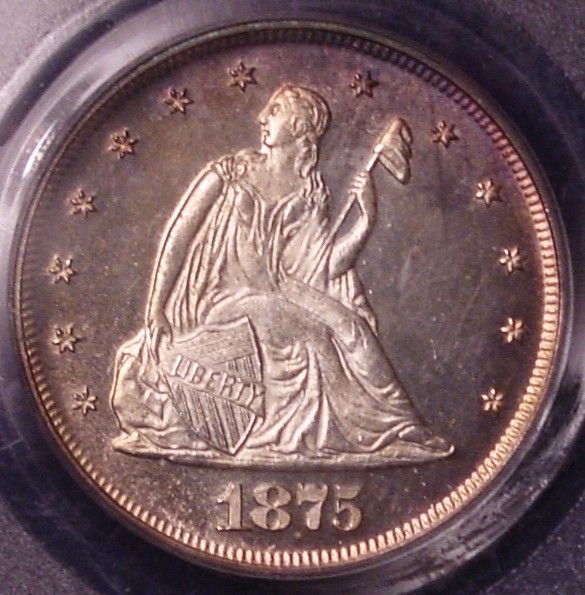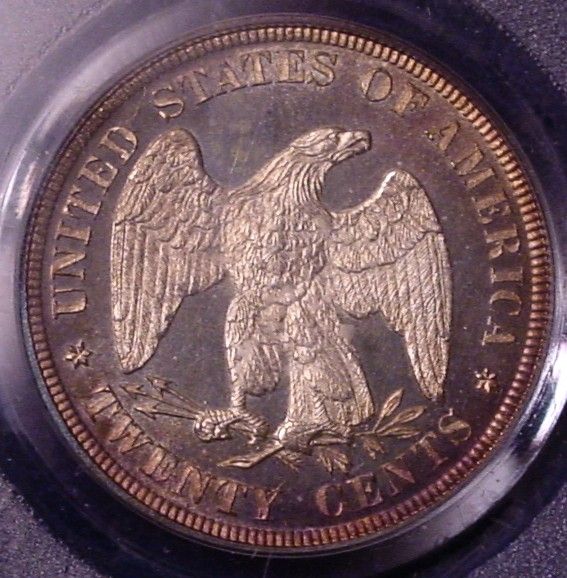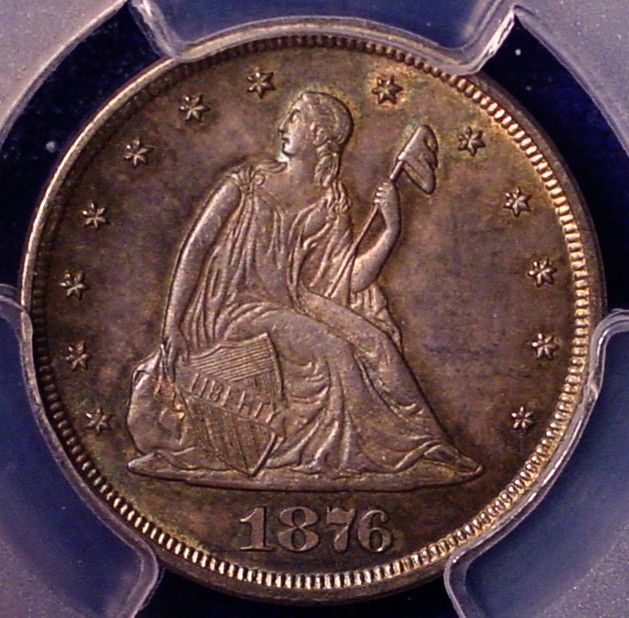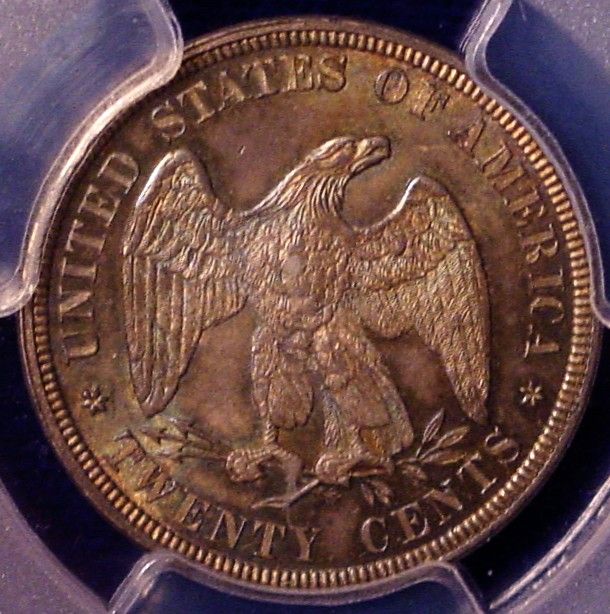An 1875 Twenty Cent Piece in PR-64, Cam
I have been fascinated by the Twenty Cent Piece since I was high school. Back then I formed a collection of the four pieces that I could afford, the 1875-P, 1875-CC, 1875-S and the 1876-P. (I know that that "P" part might seem unnecessary, but every time I post a want list for the 1875-P on a web site, I get inundated with responses that many 1875-S coins are available.  isgust
isgust
At any rate now that I'm headed toward old age, I decided to revisit this fascination of my youth. This time I can afford everything but the 1876-CC. I did see a very nice one at a Baltimore show a couple of years ago. Unfortunately the price of $550,000 was a bit past my budget at the time.
was a bit past my budget at the time.
At any rate here is my latest acquisition, and 1875-P in PR-64, Cameo. This coin is surprisingly hard to find given the reported Proof of 2,790 pieces. That is more than 1,500 coins higher than the next Proof mintage figure for the 1876-P at 1,260. One would think that the 1875-P would be the most common piece, but it isn't. Coin Facts says it's #2. My theory is that mint melted a lot of these coins after they failed to sell. It has been documented that a number of 1877 and 1878 Proof double dimes did not sell and were consigned to the melting pot.
Now I have just one more coin to find, the 1875-P in Mint State. Yes, I decided to go Proof and Unc. for this set after I found a really wonderful 1876-P in MS-65 in an auction. I already had an 1876-P in PR-65, CAC for my type set, this piece was nice I couldn't resist, given the price. Given the short nature of the Twenty Cent piece set, it only adds one more coin.


And here is the 1876


At any rate now that I'm headed toward old age, I decided to revisit this fascination of my youth. This time I can afford everything but the 1876-CC. I did see a very nice one at a Baltimore show a couple of years ago. Unfortunately the price of $550,000
At any rate here is my latest acquisition, and 1875-P in PR-64, Cameo. This coin is surprisingly hard to find given the reported Proof of 2,790 pieces. That is more than 1,500 coins higher than the next Proof mintage figure for the 1876-P at 1,260. One would think that the 1875-P would be the most common piece, but it isn't. Coin Facts says it's #2. My theory is that mint melted a lot of these coins after they failed to sell. It has been documented that a number of 1877 and 1878 Proof double dimes did not sell and were consigned to the melting pot.
Now I have just one more coin to find, the 1875-P in Mint State. Yes, I decided to go Proof and Unc. for this set after I found a really wonderful 1876-P in MS-65 in an auction. I already had an 1876-P in PR-65, CAC for my type set, this piece was nice I couldn't resist, given the price. Given the short nature of the Twenty Cent piece set, it only adds one more coin.


And here is the 1876


Retired dealer and avid collector of U.S. type coins, 19th century presidential campaign medalets and selected medals. In recent years I have been working on a set of British coins - at least one coin from each king or queen who issued pieces that are collectible. I am also collecting at least one coin for each Roman emperor from Julius Caesar to ... ?
0
Comments
Send me that 76 and I'll put a couple of little C's on it for ya, no charge!
bob
;-)
Mike
<< <i>Nice Bill,
Send me that 76 and I'll put a couple of little C's on it for ya, no charge!
bob
You would still have the double the letters of the "LIBERTY" on the shield to make it convincing.
The '75P in my 7070 album is ~XF. It has somewhat mirrored fields and a slight cameo contrast, that tells me it was likely a nice
PL coin before entering circulation. I recall reading somewhere that this is not unusual for this issue. Do you find that to be the case also?
Would these have been early circ strikes made with the Proof dies?
<< <i>Nice coins Bill, thanks for sharing, and the supplemental information.
The '75P in my 7070 album is ~XF. It has somewhat mirrored fields and a slight cameo contrast, that tells me it was likely a nice
PL coin before entering circulation. I recall reading somewhere that this is not unusual for this issue. Do you find that to be the case also?
Would these have been early circ strikes made with the Proof dies? >>
I once owned an 1875-P 20 Cent Piece that had mildly P-L fields. It was the piece I bought while I was in high school. It had the sharpness of a high end AU, but had been lightly cleaned to make it whiter. White coins were preferred by many back then, the mid 1960s. Those who collected "ugly" toned coins were viewed as kind of "odd."
I can't say that most or many business strike 1875-P double dimes were P-L because I have not seen enough of them to judge. Breen knew of only one variety for the 1875 Proof 20 Cent Pieces. That die may have been used for business, but if there was only one Proof die pair, I tend to doubt that it was for anything other than the Proofs.